#tool for Keyword Variations
Explore tagged Tumblr posts
Text
Unleash the Potential of Your Google Ads Campaigns with Our Keyword Variations Generator
In today's competitive digital advertising landscape, Google Ads campaigns are essential for businesses looking to expand their online presence and drive conversions. However, without effective keyword targeting, even the best ad copy can fail to reach its intended audience. This is where Adsteach's Keyword Variations Generator comes into play, optimizing your campaigns for unparalleled results.
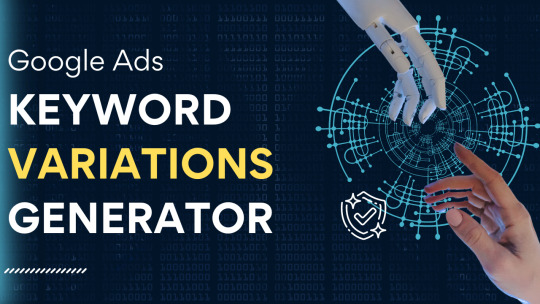
Why Keyword Variations are Essential
Keywords are the foundation of any successful Google Ads campaign, determining when and where your ads appear in search results. Relying solely on a limited set of keywords can lead to missed opportunities and reduced campaign effectiveness. Keyword variations expand your reach and ensure your ads are shown to a broader audience.
Introducing Adsteach's Keyword Variations Generator
Adsteach's Keyword Variations Generator is a powerful tool designed to streamline keyword targeting and maximize campaign performance.
Effortless Keyword Expansion: Input your desired keywords, choose match types, and our generator will create a comprehensive list of optimized variations.
Customizable Options: Customize match types to align with your campaign objectives. Our tool covers broad match, phrase match, and exact match variations.
Improved Campaign Performance: By uncovering diverse keyword variations, our tool helps you target the right audience, improving ad relevance, click-through rates, and overall campaign performance.
Time-Saving Solution: Save time and resources with our generator, eliminating the need for manual keyword research and brainstorming.
Copy and Paste Convenience: Easily integrate your new keywords into your Google Ads campaigns with just a few clicks.
About Our Tool

Our Google Ads Keyword Variations Generator makes keyword targeting easier and more effective. Simply input your desired keywords, choose your match types, and let our tool do the rest. With its intuitive interface and powerful functionality, our generator is a must-have for any digital marketer looking to maximize Google Ads campaign performance.
Conclusion
Don't let your Google Ads campaigns fall short of their potential. Unleash the potential of your Google Ads campaigns with our Keyword Variations Generator. With Adsteach's Keyword Variations Generator, you can take your advertising strategy to new heights by expanding your keyword reach, improving ad relevance, and driving better results. Unlock the full potential of your campaigns today and experience the difference our tool can make in your digital marketing efforts.
#Keyword Variations Generator#Google Ads campaigns#Google Ads Keyword Variations Generator#tool for Keyword Variations#Adsteach's Keyword Variations Generator#ads teach#free tools
0 notes
Text

SEO for YouTube: How to Optimize Your Videos for Search
Meet Paul. Paul is a budding YouTuber with a passion for tech reviews and tutorials. He’s been creating content for a while, but his channel isn’t growing as quickly as he’d hoped. Paul’s videos are high-quality, informative, and engaging, yet they’re not reaching a wide audience. The key problem? His videos are not optimized for YouTube’s search algorithm. This is where SEO, or Search Engine Optimization, comes into play.
Understanding YouTube SEO
SEO for YouTube involves optimizing your videos so they rank higher in search results. Higher ranking videos get more views, which can lead to more subscribers and overall channel growth. Here’s how Paul can optimize his videos for YouTube search:
Keyword Research
Paul’s first step is to find the right keywords. Keywords are the terms and phrases that users type into the search bar when looking for videos. Paul uses tools like Google Trends, TubeBuddy, and VidIQ to identify popular keywords related to his content. For instance, if Paul’s video is about the latest iPhone review, he might discover that “iPhone 14 review,” “iPhone 14 unboxing,” and “iPhone 14 vs Samsung Galaxy S22” are popular search terms.
Optimizing Video Titles
Once Paul has his keywords, he needs to incorporate them into his video titles. A good title is clear, concise, and includes the main keyword. For example, instead of titling his video “My Thoughts on the New iPhone,” Paul titles it “iPhone 14 Review: In-Depth Look at Apple’s Latest Smartphone.” This title is more likely to match what users are searching for.
Creating Engaging Thumbnails
Thumbnails are the first thing viewers see. An eye-catching thumbnail can significantly increase click-through rates. Paul creates custom thumbnails that are visually appealing and relevant to the video content. He includes the video title or key phrases in the thumbnail to attract viewers’ attention.
Writing Detailed Descriptions
The video description is another crucial SEO element. Paul writes detailed descriptions for his videos, incorporating his main keyword and related terms naturally. He includes a brief summary of the video, timestamps for different sections, and links to his social media, website, and other relevant videos. This not only helps with SEO but also provides a better viewer experience.
Using Tags Effectively
Tags help YouTube understand the content of a video. Paul uses a mix of broad and specific tags, including his main keyword and variations of it. For his iPhone review video, he might use tags like “iPhone 14,” “iPhone review,” “Apple smartphone review,” and “tech reviews 2023.”
Engaging with Viewers
Engagement metrics like likes, comments, and watch time also influence search rankings. Paul makes an effort to engage with his audience by asking questions in his videos, responding to comments, and encouraging viewers to like and share his videos. The more engagement his videos get, the higher they are likely to rank.
Promoting Videos on Social Media
Paul doesn’t rely solely on YouTube’s search algorithm to drive traffic. He promotes his videos on social media platforms like Twitter, Facebook, and Instagram. By sharing his videos with a broader audience, he increases the chances of getting more views and engagement.
Analyzing and Adjusting
Finally, Paul regularly reviews his analytics to understand what’s working and what’s not. He looks at metrics like watch time, click-through rates, and viewer retention. Based on this data, Paul adjusts his SEO strategy and content approach to continually improve his channel’s performance.
Conclusion
Through consistent effort and strategic optimization, Paul starts to see his videos rank higher in YouTube search results. His channel grows steadily, attracting more viewers and subscribers. By following these SEO practices, Paul not only improves his search rankings but also enhances the overall quality and reach of his content.
For any YouTuber looking to grow their channel, understanding and implementing YouTube SEO is crucial. Just like Paul, you too can optimize your videos and achieve greater success on the platform.
60 notes
·
View notes
Text
Color Monologue
Because color is one of my obsessions, I figured I’d share this. It’s nice to have names for the colors we don’t often have words to describe.
Below are some charts for examples, followed by a personal monologue.
List of Colors: 550 Color Names and Hex Codes
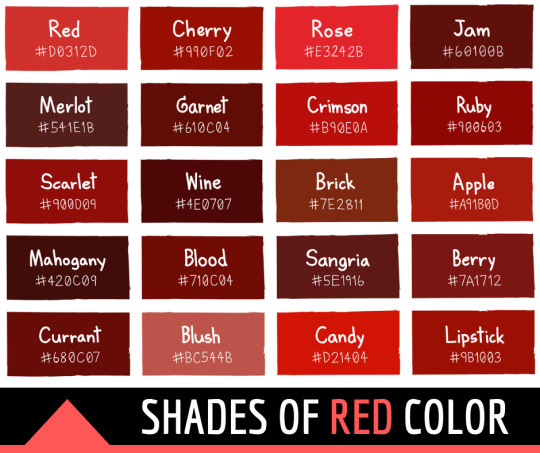
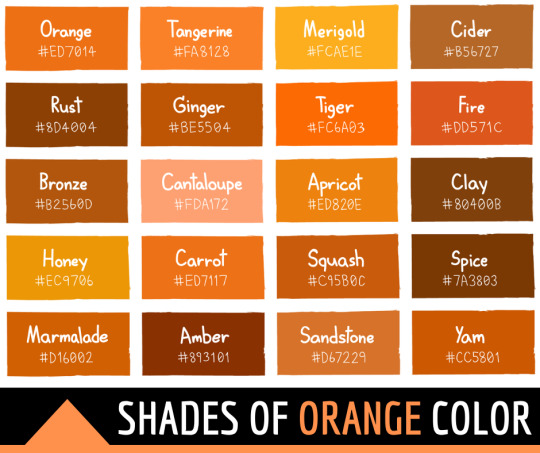
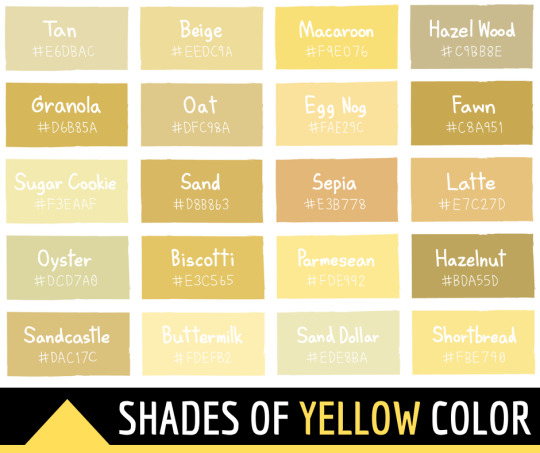
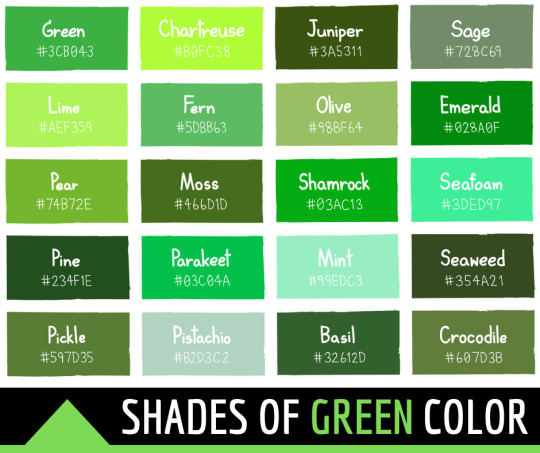
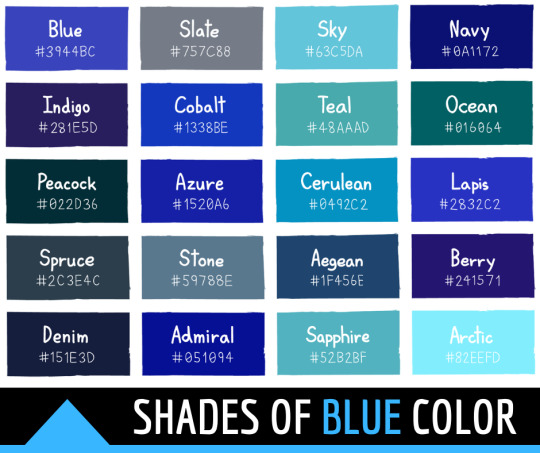
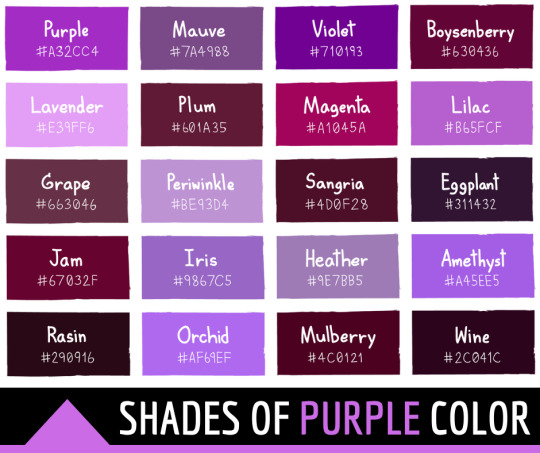
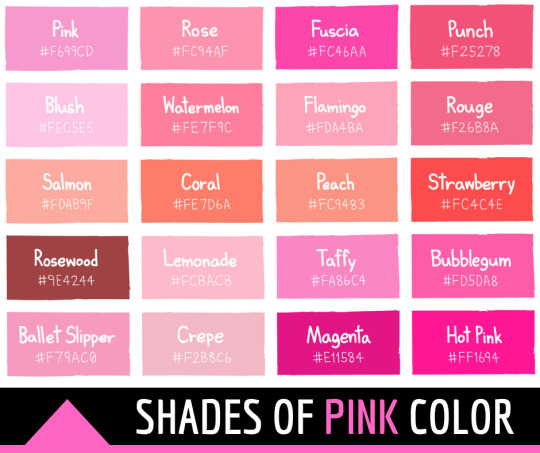
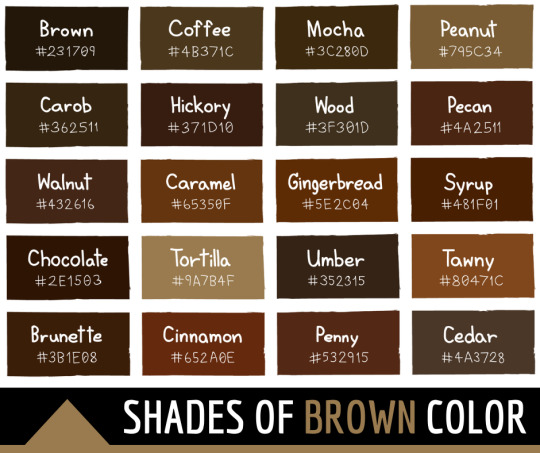
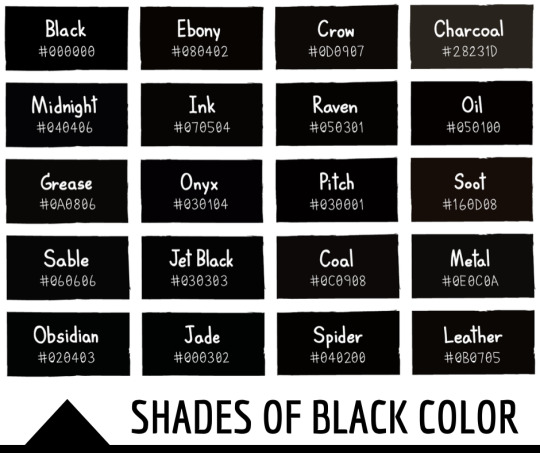
(If you can distinguish between these shades of black, let me know…. I can’t! Lol)
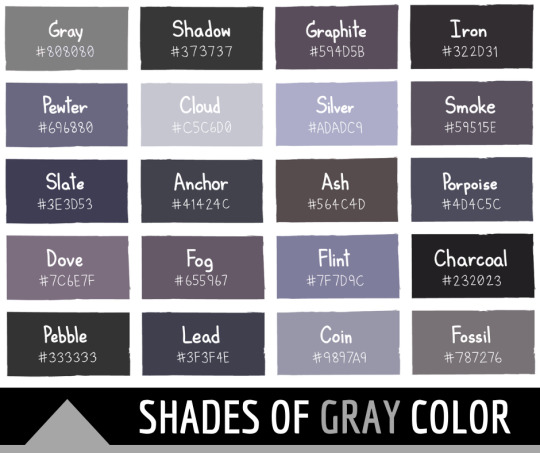
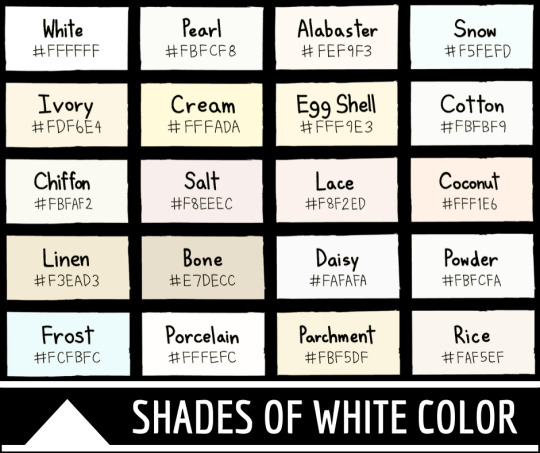
Finding My Favorite Color
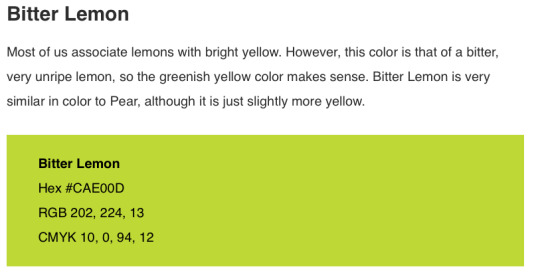
Spoiler alert: It’s #E0EE00
Their “summary” color charts don’t include my favorite color, so I went into their more in-depth lists and found Bitter Lemon, which I think is about right. Actually, this “traditional” Chartreuse is likely closer:
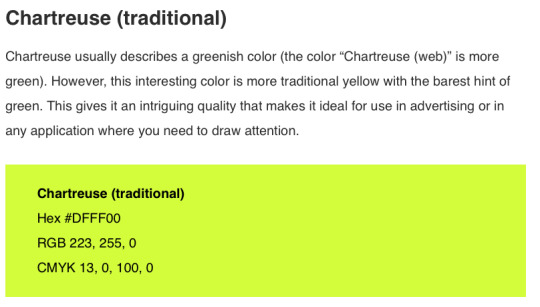
My Favorite Color is an Experience
When people ask me what my favorite color is, I may come off as ridiculous when I respond “the color of new spring leaves when sunlight shines through them,” but it’s really the truth.
I care a lot about that exact sensation. It’s very captivating to me. I don’t even have to get on a plane to witness it. I can just go down the street or to a local park.
The experience of standing under a tree and gazing up through its branches is enchanting, and this array of color tones glows around me and inside of me. The below image kind of communicates this idea.

I particularly like the yellower green, right where the sun hits the leaves. Source
The term “chartreuse” is still inexact because the examples provided are usually not yellow enough.
This next pic is just for fun:

Source
Using a Color Picker to Find My Favorite Color
Here are some more examples of my favorite color.
Color Picker Source I’m aware these are multiple shades, but oh well. I’m searching.
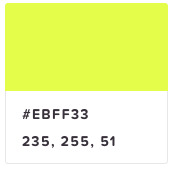

Sometimes I feel like I get to my favorite color fastest if I go to yellow first, then darken it a little.
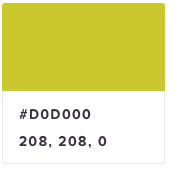
Funny how this color now looks worse as I place it against the dark background of Tumblr. In fact, it looks like boogers and I don’t like it as much at all.
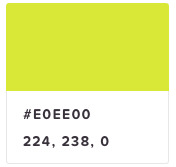
The hex code “E0EE00” is really satisfying. Old Macdonald had a farm, E-0, E-E, 0-0…..
I think I’ll settle there for now.
Clothing With (Almost) My Favorite Color

Source

Source
It’s very, very difficult and rare to find clothing in my favorite color.
Is Chartreuse Green or Yellow?
(and who cares?)
Sometimes I wear a sweater from F21 that is pretty close to my favorite color, and people compliment me on my “yellow sweater,” at which I am always amused. To me, the sweater is green. So I have fun randomly asking people if they think the sweater is yellow or green. I just like to see which one they say. There are no wrong answers. I, too, remain uncertain as to which general category my favorite color inhabits. Relatedly, “Chartreuse” falls under “Green,” while “Chartreuse (traditional)” falls under “Yellow” on the first website I linked, List of Colors: 550 Color Names and Hex Codes. (Their version of “Chartreuse” I do not like at all. It is way too blue-green and not yellow at all.) Well, It’s a good thing that the determination of whether this shade is “yellow” or “green" is not particularly important one way or the other, because if people cared about this, I do think they’d never come to a consensus.
Clothing Website Color Pickers
I do, however, wish clothing websites would recognize “chartreuse” in a keyword search or have a more intelligent color picker when filtering results. It would not be too hard to code a tool that analyzes each clothing image and provides 10-20 color names depending on the hex codes it picks up. One could build in a “margin of error” where hex codes that are within a few degrees of variation are also included under those names. So the user could actually use a color picker (or a longer selection of specific colors, at least) to filter by color, and all matching or near-matching clothes would be included in the results.
Thanks for coming to my color monologue!

Source
#colors#color chart#color names#colorful#art#colorful art#color-meanings.com#color meanings#yellow#red#orange#black#white#blue#green#chartreuse#color monologue#hex codes#hex color codes#hexadecimal codes#hexadecimal#color picker#html color codes#html#hex#clothing#fashion#green clothes#st. patrick’s day#rare colors
9 notes
·
View notes
Text
【親職講堂】練字莫貪早:讓幼兒幾歲開始寫字?刻意練字的適齡兒童是幾歲?從骨骼年齡與精細動作發展、硬筆鋼筆寫字精準練習方法談起
【Parent-Child Learning】Don’t Rush Handwriting: When Should Children Start Writing? Optimal Age for Deliberate Practice, Skeletal Maturity, Fine Motor Development, and Precision Training with Hard Pen and Fountain Pen

Abstract This article provides an in-depth exploration of the appropriate age for children to begin learning handwriting, integrating insights from developmental psychology, pediatric orthopedics, calligraphy pedagogy, and parent-child education. Drawing upon hundreds of consultations with in-service teachers, pre-service educators, and concerned parents, the article addresses a top recurring question in early childhood education: When is the right time for children to start deliberate handwriting training?

Research suggests that the ideal age range is between 6 to 8 years old, with 7 as a developmental average. This recommendation is based on the maturation of fine motor skills and the ossification of finger bones, with studies showing that girls generally mature earlier than boys in skeletal development. Starting formal handwriting instruction too early can lead to improper writing habits, muscle fatigue, or even joint deformities, which are difficult to correct later.
Before age six, children are encouraged to explore various writing tools through scribbling and free-form drawing, which fulfill expressive and sensorimotor needs rather than aim for accuracy or calligraphic form. Scribbling represents a critical pre-literacy and pre-calligraphic stage, fostering creativity and natural motor exploration.

The article also outlines three key principles of precision handwriting training:
From Large to Small – Start with larger writing grids (e.g., 2cm×2cm) for hard-pen practice.
From Easy to Difficult – Begin with basic strokes, then progress to radicals, and eventually full characters.
From Hard to Soft – Begin with hard pens (ballpoint or fountain pens), then gradually introduce brush calligraphy to achieve expressive line control and pressure variation.
A unique feature of Chinese calligraphy lies in the dynamic pressure techniques such as Ti-An (lifting and pressing), which rely heavily on refined muscle control. For example, a single stroke may involve multiple shifts in strength and direction, illustrating the union of physical development and conscious artistic engagement.
This article reminds educators and parents: Do not rush handwriting instruction. Early writing should be natural and exploratory; structured and precise training should wait until the child's body and mind are ready. Pushing too early may backfire, delaying progress rather than accelerating it. Instead, observe, support, and time it right—handwriting is not a race, but a lifelong craft.

Keywords: handwriting instruction, fine motor skills, skeletal maturity, developmental readiness, hard pen calligraphy, early childhood education, calligraphy pedagogy, Ti-An technique, pressure control, parent-child learning, scribbling, Chinese calligraphy education
🌾 罐子老師的書法教室-Taiwan calligraphy educator Ph.D instagram.com/handwrite520
#硬筆書法#鋼筆書法#書法老師#寫字老師#書法教室#寫字教室#練字#幼兒#幼兒練字#幼兒寫字#精細動作#精緻肌肉#書法#書藝#書道#書法藝術#潛能開發#課程與教學#骨骼發展#手指#發展心理學#書法研究#推動書法教育計畫
2 notes
·
View notes
Text

What Mistakes Are Causing Your Website to Lose Rank?
If your website traffic is slowly dropping — or suddenly tanked — it’s not just bad luck. It’s likely the result of avoidable SEO mistakes.
As an SEO expert, I’ve seen countless sites suffer in search rankings due to a few common (but critical) issues. Let’s break down the most damaging ones:
1. Low-Quality or Thin Content
Google is laser-focused on quality. If your content doesn’t provide real value, depth, or unique insights — you’re at risk.
Fix: Focus on user intent. Offer solutions, not just keywords.
2. Slow Loading Speed & Poor Core Web Vitals
If your site is slow, users bounce — and Google notices.
Fix: Use tools like Google PageSpeed Insights or GTmetrix to identify speed issues and fix them ASAP.
3. Not Mobile-Friendly
With over 60% of searches now on mobile, a non-responsive website is a big red flag.
Fix: Optimize your design for smaller screens and test across devices.
4. Duplicate or Outdated Content
Google hates repetition and stale info. It wants fresh, original content.
Fix: Consolidate duplicate pages and update older posts regularly.
5. Broken Links and Technical Errors
404 pages, broken links, or crawling issues can sink your rankings.
Fix: Perform regular technical audits using Google Search Console or tools like Screaming Frog.
6. Keyword Stuffing & Over-Optimization
Yes, keywords are important — but overdoing it looks spammy.
Fix: Write for humans first. Use variations and natural language.
💥 Final Thoughts:
SEO isn’t just about adding keywords or getting backlinks. It’s about delivering real value, fast performance, and a flawless user experience.
Clean up these common mistakes, and you’ll likely see your rankings rebound — or even skyrocket.
🔍 Which of these mistakes have you faced — and how did you fix them? Let’s discuss in the comments.
📰 Don’t forget to subscribe for daily SEO updates and expert insights.
#seo marketing#seo services#sẹo#googleranking#seotips#digitalmarketing#websitetraffic#linkedinnewsletter#instagramgrowth#instagrammarketing
2 notes
·
View notes
Text
THE RISE OF AUTONOMOUS MARKETING: HOW AI TOOLS ARE TAKING OVER ROUTINE TASKS
In the ever-evolving landscape of digital marketing, a seismic shift is underway. The rise of autonomous marketing, powered by artificial intelligence (AI), is transforming how businesses engage with their audiences, optimize campaigns, and drive growth. Routine tasks that once consumed hours of human effort, like content creation, data analysis, ad optimization, are now being handled by intelligent AI tools with unprecedented efficiency and precision. This revolution is not just about automation; it’s about empowering marketers to focus on creativity, strategy, and human connection while machines handle the repetitive grind. In this blog, we’ll dive deep into the rise of autonomous marketing, explore how AI tools for digital marketing professionals, AI-powered content marketing course, are reshaping the industry, discuss what this means for the future of marketing, and why we should learn digital campaign optimization with Ai.
The Dawn of Autonomous Marketing
Marketing has always been a blend of art and science, requiring both creative flair and data-driven precision. However, the sheer volume of tasks involved like keyword research, social media scheduling, email campaign management, performance tracking, can overwhelm even the most seasoned professionals. Enter autonomous marketing: a paradigm where AI tools take over repetitive, time-consuming tasks, allowing marketers to focus on high-level strategy and innovation.
The adoption of AI tools for digital marketing professionals has skyrocketed in recent years. According to a 2023 report by HubSpot, 64% of marketers now use AI-based tools to streamline their workflows, with adoption rates expected to climb further by 2026. From generating personalized email content to optimizing paid ad campaigns in real time, AI is proving to be a game-changer. These tools don’t just save time; they enhance decision-making by analysing vast datasets that no human could process in a reasonable timeframe.
How AI Tools Are Transforming Routine Marketing Tasks
Let’s break down some of the key areas where autonomous marketing is making its mark, with a focus on AI-powered content marketing course, and learn digital campaign optimization with AI
1. Content Creation and Curation
Content is the lifeblood of digital marketing, but crafting blog posts, social media updates, and email newsletters can be a slog. AI-powered tools like Jasper, Copy.ai, and ChatGPT have revolutionized AI-powered content marketing course by generating high-quality, human-like content in seconds. These platforms use natural language processing (NLP) and generative AI to produce everything from catchy ad copy to long-form blog posts tailored to specific audiences.
For example, a small e-commerce brand can use AI to create product descriptions optimized for SEO, ensuring they rank higher on search engines without hiring a team of copywriters. AI tools also analyse audience preferences to suggest topics, headlines, and even visual elements that resonate. By automating content ideation and creation, marketers can focus on strategy, deciding which stories to tell and how to tell them, while AI handles the heavy lifting.
To learn AI-powered content marketing course is particularly relevant here, as it encapsulates the shift from manual content creation to AI-driven efficiency. It also equips you with cutting-edge strategies to leverage artificial intelligence for creating, optimizing, and automating high-impact marketing campaigns.
2. Campaign Optimization and Performance Tracking
Running a successful digital campaign requires constant tweaking like adjusting ad budgets, refining target audiences, and testing creative variations. This is where learning digital campaign optimization with AI shines. Tools like Google’s Smart Bidding, Meta’s Advantage+ campaigns, and platforms like AdRoll use machine learning to analyse real-time data and optimize campaigns on the fly.
Imagine launching a Facebook ad campaign for a new product. An AI tool can monitor click-through rates, conversions, and audience engagement, then automatically shift budgets to the best-performing ads or demographics. This level of precision was once the domain of highly skilled analysts, but AI now democratizes it, making advanced optimization accessible to small businesses and solo entrepreneurs.
Moreover, AI tools provide predictive analytics, forecasting campaign outcomes based on historical data and market trends. For instance, platforms like HubSpot and Salesforce use AI to predict which leads are most likely to convert, enabling marketers to prioritize high-value prospects. By learning digital campaign optimization with AI, businesses achieve higher ROI with less manual effort.
3. Social Media Management
Social media is a cornerstone of modern marketing, but managing multiple platforms like Twitter, Instagram, LinkedIn, TikTok, can feel like a full-time job. AI tools like Hootsuite, Buffer, and Sprout Social automate scheduling, content curation, and performance tracking, while advanced platforms like Lately use AI to repurpose long-form content into bite-sized social posts.
AI also enhances audience engagement through chatbots and personalized responses. For example, an AI-powered chatbot can handle customer inquiries on Instagram, recommend products, and even process orders, all while mimicking a human tone. This not only saves time but also ensures 24/7 responsiveness, which is a must in today’s always-on digital world.
The phrase "AI tools for digital marketing professionals" effectively captures the practical resources that enable marketers to streamline social media management, showcasing the transformative potential of these technologies.
4. Email Marketing and Personalization
Email remains one of the most effective marketing channels, with an average ROI of $36 for every $1 spent, according to Litmus. However, crafting personalized emails for thousands of subscribers is a logistical nightmare. AI tools like Mailchimp’s AI-driven features and Klaviyo automate email segmentation, content generation, and send-time optimization.
For instance, AI can analyse a subscriber’s purchase history, browsing behaviour, and engagement patterns to craft hyper-personalized emails, think product recommendations or tailored discounts. Tools like Phrasee use AI to optimize email subject lines, increasing open rates by predicting which phrases will resonate most. By automating these tasks, marketers can deliver personalized experiences at scale without burning out.
5. SEO and Keyword Research
Search engine optimization (SEO) is another area where AI is taking over routine tasks. Tools like SurferSEO, Ahrefs, and SEMrush use AI to analyse search trends, competitor strategies, and on-page performance, providing actionable recommendations to boost rankings. For example, AI can suggest high-performing keywords, optimize meta tags, and even identify content gaps on a website.
This automation is a lifeline for small businesses that lack the resources for dedicated SEO teams. By learning AI tools for digital marketing professionals, marketers can implement sophisticated SEO strategies without spending hours on manual research.
The Benefits of Autonomous Marketing
The rise of autonomous marketing brings a host of benefits that extend beyond time savings. Here are some of the most impactful ones:
Scalability: AI tools allow businesses of all sizes to execute complex marketing strategies without proportional increases in staff or budget. A single marketer with the right AI tools can manage campaigns that rival those of large agencies.
2. Precision: AI’s ability to analyse massive datasets ensures decisions are data-driven, reducing guesswork and improving outcomes. For example, learning digital campaign optimization with AI ensures ad spend is allocated to the most effective channels and audiences.
3. Cost Efficiency: By automating routine tasks, businesses save on labour costs and reduce the need for outsourcing. AI tools often offer tiered pricing, making them accessible to start-ups and enterprises alike.
4. Enhanced Creativity: With AI handling repetitive tasks, marketers have more time to focus on creative storytelling, brand building, and customer engagement. This human-AI collaboration unlocks new levels of innovation.
5. 24/7 Operations: AI tools don’t sleep. They monitor campaigns, respond to customers, and optimize performance around the clock, ensuring businesses stay competitive in a global market.
Challenges and Considerations
While autonomous marketing is transformative, it’s not without challenges. Over-reliance on AI can lead to generic content or a loss of brand voice, as algorithms may prioritize optimization over authenticity. Additionally, ethical concerns such as data privacy and algorithmic bias—require careful navigation. For instance, AI tools that analyse consumer behaviour must comply with regulations like GDPR and CCPA to protect user data.
There’s also the learning curve. While AI tools for digital marketing professionals are designed to be user-friendly, mastering them requires some training. Fortunately, resources like online courses and tutorials (many of which focus on AI-powered content marketing course or learning digital campaign optimization with AI) are widely available to bridge this gap.
The Future of Autonomous Marketing
As AI technology advances, the possibilities for autonomous marketing are limitless. Generative AI models like GPT-4 and beyond will create even more sophisticated content, while deep learning algorithms will enable hyper-accurate audience targeting. We’re also seeing the rise of AI-powered creative tools that generate visuals, videos, and interactive experiences, further blurring the line between human and machine creativity.
In the next decade, autonomous marketing could evolve into fully self-managing systems, where AI not only executes tasks but also sets strategies based on business goals. Imagine an AI that designs an entire marketing funnel, from awareness to conversion, without human input. While this may sound like science fiction, companies like xAI (creators of Grok) are already pushing the boundaries of AI’s role in decision-making.
Conclusion: Embracing the AI Revolution
The rise of autonomous marketing is not about replacing humans but about amplifying their potential. By leveraging AI tools for digital marketing professionals, AI-powered content marketing course, and learning digital campaign optimization with AI, businesses can achieve unprecedented efficiency, scalability, and impact. These tools are democratizing access to advanced marketing techniques, levelling the playing field for small businesses and solo entrepreneurs.
As we move into 2025 and beyond, marketers must embrace AI as a partner, not a threat. The future belongs to those who can blend human creativity with machine precision, crafting campaigns that resonate deeply while scaling effortlessly. Whether you’re a seasoned professional or just starting out, now is the time to explore AI’s potential and ride the wave of autonomous marketing. The tools are here, the opportunities are endless, and the revolution is just beginning.

#artificial intelligence#marketing#digital marketing#automation#technology#innovation#ai trends#futuretech#marketing strategy
3 notes
·
View notes
Text
Shufflemancy Testing: 50 Song Playlist Summary
Shufflemancy theory testing is underway. I did a lot of thinking on how I wanted to do this, and it came down to the information I was trying to glean in the end.
My Method
My primary concerns with shufflemancy (and, indeed, other forms of divination using digital tools) are: 1) The interference of algorithms in the shuffle process; and 2) The lack of variety and length in a given playlist.
To address both concerns at once, I came up with the idea of creating several playlists of increasing length. Each playlist contains all songs from the one preceding it, plus an entirely new selection of songs sourced from my many, many playlists and from others' massive playlists at random. They are 50, 100, 200, 500, and 1,000 songs, respectively.
I'm skipping the same number of songs each day (hitting play in the list to start it in Spotify, then skipping 3 songs) while asking the same question at the same time ("What should I expect today?")
Ideally, I would do this every day. But... well, ADHD strikes, and I missed a couple days. Even so, I decided at the start to dedicate a full week to the process, and so I've stuck to seven days to test each playlist.
It's worth noting that I have little to no shufflemancy experience prior to this. I'm aware that my lack of skill and expertise may affect the quality of my divinations with this, so I plan on returning to the 50 and 100 song playlists after the 1,000 song playlist just to be certain my skill level isn't playing into the output.
Once I've completed the circuit and have a baseline using these criteria, it's time to... do it all again, kinda. But with a change! I eventually want to answer the following questions:
Are songs more accurate first thing when I start my day, or are they better done the night before?
Does the number of songs make a significant difference? Does seven skips yield a better or worse result than three? What about five, or ten?
Is a longer-winded dissection of the song's themes, background, and artist more or less accurate than a basic impression? Or, on the other hand, does a bare bones, keyword-based description work best?
Does the information I'm taking down matter? Are the tempo, tone, and length relevant somehow? Or does the title, lyrics that "pop out" at me, and overall themes of the song do the job?
To answer these questions, I'll choose whichever playlist ends up being the most accurate and make individual variations to be tested over a seven-day period.
As I've mentioned before, I'm using Spotify for this test. But once I feel I've done all I can there... I'm swapping platforms. That's right, I'm not just testing shufflemancy itself, I'm testing to see which platform is really best for it!
This whole process is going to take a long while. I plan on updating with full details for Ko-Fi supporters fairly regularly, with a breakdown of songs I shuffled to and my notes during and the day after. Folks on Tumblr will see a basic list of songs and ratings for how accurate it was to the day in question.
With all that said, I've done seven full days with the 50 song playlist. How did it go, you ask?
50 Song Playlist Breakdown
Day One
Question: What should I expect today? Shuffles: 3 Times Song: "What It Takes" Artist: Aerosmith Rating: 3/10
Day Two
Question: What should I expect today? Shuffles: 3 Times Song: "I'm So Tired" Artist: Fugazi Rating: 1/10
Day Three
Question: What should I expect today? Shuffles: 3 Times Song: "Professional Griefers" Artist: deadmau5, Gerard Way Rating: 3/10
Day Four
Question: What should I expect today? Shuffles: 3 Times Song: "I Wanna Be Your Man" Artist: Willy Moon Rating: 6/10
Day Five
Question: What should I expect today? Shuffles: 3 Times Song: "Megalovania" Artist: Toby Fox Rating: (a generous) 5/10
Day Six
Question: What should I expect today? Shuffles: 3 Times Song: "Halloweenie IV: Innards" Artist: Ashnikko Rating: 7/10
Day Seven
Question: What should I expect today? Shuffles: 3 Times Song: "Fancy" Artist: Iggy Azalea Rating: 0/10
Average Rating: 3.7/10
To see a full breakdown of each day, including lyrics that stood out, my immediate takeaways, and post-reading dissections, visit my Ko-Fi page! The full article is exclusive for supporters -- as little as $1 gets you access to my full backlog.
#aese speaks#shufflemancy#divination#digital divination#technomancy#tech magic#techno magic#witchblr#witchcraft#witchy research
18 notes
·
View notes
Text
The Role of Semantic Search in Modern SEO Services San Francisco
In today’s dynamic digital landscape, search engine optimization (SEO) is no longer just about inserting the right keywords into your content.
With the rise of AI-powered algorithms and user-centric search experiences, semantic search has become a core component of modern SEO strategies. But what exactly is semantic search, and how is it transforming SEO Services San Francisco? Let’s explore.
What is Semantic Search?
Semantic search refers to the process by which search engines attempt to understand the intent and context behind a user’s query rather than relying solely on keyword matches. Instead of looking at search terms in isolation, semantic search interprets meaning by analyzing:

The relationship between words
User search history and location
Natural language queries
Synonyms and variations
Structured data and entity recognition
Search engines like Google now aim to deliver results that are not just textually relevant but also contextually accurate, thanks to major algorithm updates like Hummingbird, RankBrain, and BERT.
Why Does Semantic Search Matter in SEO?
In the past, SEO success depended heavily on keyword density, exact match phrases, and backlink quantity. But today’s search engines are much smarter. They understand that a user searching for "how to fix a leaky faucet" doesn’t just want a page that repeats that phrase ten times—they want a helpful guide, perhaps with step-by-step instructions and tools needed.
Here’s how semantic search impacts modern SEO:
1. Focus on Search Intent
Understanding user intent is now critical. Are users looking for information, trying to make a purchase, or comparing products? Semantic search helps deliver tailored content that aligns with the user’s goal, and SEO professionals must optimize content accordingly.

2. Natural Language and Conversational Queries
With the rise of voice assistants and AI chatbots, people are using more natural, conversational queries. Phrases like “best pizza place near me” or “how can I improve my sleep quality?” require semantic understanding. SEO now involves optimizing for these long-tail and question-based keywords.
3. Topic Clusters over Keywords
Modern SEO emphasizes topic relevance rather than isolated keywords. Creating content clusters around core themes helps search engines understand the depth and authority of a website. For example, a health blog writing about “diabetes” should also cover related topics like diet, insulin, symptoms, and treatments.
4. Structured Data and Schema Markup
Semantic search engines benefit from clear, structured data. Using schema markup allows search engines to better understand your content, which can improve rankings and increase chances of rich snippets appearing in search results.

5. User Experience and Engagement Metrics
Since semantic search prioritizes delivering the most useful content, user experience (UX) plays a major role. High bounce rates, low time on page, and poor mobile optimization can negatively affect rankings. SEO services now need to align content relevance with fast, intuitive website design.
How are SEO Services Adapting?
SEO agencies and professionals have shifted from keyword stuffing to creating meaningful, high-quality content. Here’s how they’re leveraging semantic search:
Conducting intent-based keyword research instead of generic keyword lists
Creating comprehensive content hubs that satisfy multiple user intents
Using AI and NLP tools to analyze semantic relationships
Optimizing FAQs and voice-friendly content
Implementing structured data to enhance content discoverability
Final Thoughts
Semantic search is not a passing trend—it’s the foundation of how modern search engines work. For businesses, this means SEO is no longer a technical back-end task but a holistic digital strategy that includes content marketing, UX, and even AI.
To stay ahead in the SEO game, brands must shift their focus from keywords to meaning, from volume to value. By embracing semantic search, businesses can deliver better experiences, reach more relevant audiences, and rank higher in today’s intelligent search engines.
2 notes
·
View notes
Text
The Complete Manual for SEO in 2025: Methods to Rule Search Results
Digital marketing
Because Google's algorithms are becoming more intelligent and user behavior is changing, search engine optimization, or SEO, is always changing. To stay ahead of the curve in 2025, you will need to combine technical know-how, excellent content, and strategic link-building. If you are a blogger, digital marketer, or business owner, learning SEO can help you increase conversions and drive organic traffic.
In order to help you dominate search engine rankings in 2024, we will examine the most recent SEO tactics in this guide.
1. Recognizing SEO in 2025
Enhancing your website's visibility on search engines such as Google and Bing is known as SEO. A higher ranking for pertinent keywords, organic traffic, and improved user experience are the objectives.
Relevance, authority, and high-quality content are given top priority by search engines. Google's algorithms have become increasingly complex in comprehending search intent and rewarding websites that offer genuine value as a result of developments in AI and machine learning.
2. Keyword Analysis: The Basis for SEO
The foundation of SEO is still keyword research. But in 2025, search intent will be more important than ever. Take into account the following rather than just high-volume keywords:
Long-tail keywords are longer, more focused terms with higher conversion rates and less competition.
Semantic keywords: Include synonyms and variations of your primary keyword because Google's algorithms can comprehend related terms.
Keywords that are based on questions: A lot of users enter terms like "how to," "best way to," or "why does." By responding to these questions, you can increase how likely you are to be featured in snippets.
The Top Resources for Researching Keywords:
For both PPC and organic search insights, Google Keyword Planner is a free and helpful tool.
Ahrefs: Offers competitor analysis, search volume, and keyword difficulty.
SEMrush: Provides backlink analysis, site audits, and keyword research.
Finding frequently asked questions about your subject is made easier with AnswerThePublic.
3. Optimizing Your Content with On-Page SEO
Improving search rankings by optimizing individual pages is known as on-page SEO. Here's how to make your content better:
a. Meta descriptions and title tags
Your title tag should contain your target keyword, be compelling, and be no more than 60 characters. Likewise, your 160-character meta description should enticingly summarize your content and entice readers to click.
b. Header tags, such as H1, H2, and H3.
Use the main title in H1.
Utilize H2s and H3s for subheadings to enhance structure and readability.
Naturalize the use of primary and secondary keywords.
c. Optimizing URLs
A clean, descriptive URL helps both search engines and users. Example: Bad URL: www.example.com/p=12345 Visit www.example.com/seo-strategies-2025 for a good URL.
d. Linking Inside
Link equity is distributed, navigation is improved, and user engagement is prolonged when you link to other pertinent pages on your website.
e. Optimization of Images
To speed up page loads, reduce the size of images.
To help search engines understand images, use alt text to describe them.
4. Improving Website Performance with Technical SEO
Making a site's backend better for search engines to crawl and index is the main goal of technical SEO.
A. Optimization for Mobile
As mobile-first indexing is the standard, make sure your website is responsive. Google's Mobile-Friendly Test can be used to test your mobile performance.
b. Page Speed and Essential Web Elements
Google takes into account Core Web Vitals (LCP, FID, and CLS) and page speed when determining rankings. Boost speed by:
making use of a content delivery network (CDN).
making videos and pictures better.
turning on browser caching and minifying JavaScript and CSS.
c. Make Your Website Secure with HTTPS
Safe websites are given priority by Google. Convert your website to HTTPS if it still uses HTTP for better search engine rankings and user confidence.
Robots.txt and XML Sitemap
Make sure that all of the key pages are indexed by submitting an updated XML sitemap to Google Search Console. A robots.txt file can also be used to prevent the crawling of unnecessary pages.
5. Developing Authority and Trust through Off-Page SEO
a. Creating Links
One important ranking factor is still backlinks. Quantity is not as important as quality. Pay attention to:
guest posting on trustworthy websites.
Links are created by having high-quality content.
"Broken link building" is the process of identifying and fixing broken links.
Consider using HARO (Help A Reporter Out) to get backlinks from news websites.
b. Social Media Brand Mentions
Despite social signals not being direct ranking factors, a strong social media presence can boost credibility and drive traffic.
c. Local SEO and Internet critiques
If your business operates locally, encourage customers to leave positive reviews on Google My Business and Yelp. The local SEO rankings of your business are also raised when local citations contain your company's name, address, and phone number.
7. The Growth of Voice and Zero-Click Searches
It is imperative to optimize for voice search given the popularity of smart assistants like Alexa and Siri.
Make use of FAQs and keywords in natural language.
Because many voice searches are location-based, make sure your website is optimized for local search engines.
There is also an increase in zero-click searches, in which Google provides an answer right in the SERP. In order to appear in featured snippets:
Give succinct, well-organized responses.
For clarity, use lists and bullet points.
8. The Synergy of Content Marketing and SEO
Content marketing and SEO are closely related. For 2025 success, concentrate on
1,500+ words of long-form content that offers comprehensive answers.
Integration of multimedia (podcasts, infographics, and videos).
User interaction promotes sharing, comments, and conversations.
9. Tracking and Enhancing SEO Results
Use resources such as:
Google Analytics: Monitors conversions, traffic, and bounce rates.
Data on indexing and keyword performance is provided by Google Search Console.
Analysis of competitors and backlinks is provided by Ahrefs and SEMrush.
Important data to monitor:
an increase in organic traffic.
ranking of keywords.
CTR stands for click-through rates.
bounce rates and dwell time.
Conclusion: Make Your SEO Strategy Future-Proof
The process of SEO is continuous and necessitates continuous modification. Creating valuable content, staying up to date with algorithm changes, and focusing on technical optimizations are all ways to maintain high search rankings in 2025.
Ready to make your website more successful? Put these tactics into practice right now, and see how your organic traffic increases!

2 notes
·
View notes
Text
📖 Master the Art of Writing Niches & SEO! ✍️💡
🔑 Boost Your Content with Powerful Keyword Strategies! This book is your ultimate step-by-step guide to crafting ✨ catchy titles that grab attention & using 🎰 article title generators to create multiple variations in seconds.
🛠️ Discover the Best Writing Tools for Authors: 🔊 Voice Recognition Software – Write hands-free! 🎨 Visual Thesaurus – Find the perfect words! 🧠 Mind Mapping Tools – Organize your creative ideas! 🖊️ OpenOffice for Writers – Draft like a pro! 🌍 Mozilla Firefox for Research – Speed up fact-finding!
💡 Supercharge Your Idea Generation! 📝 Create Word Lists to fuel creativity! 🤔 Brainstorm Faster with productivity hacks! 🔎 Google Search Tricks to cut research time in half!
📚 For Beginners & Experts Alike! 🖋️ Engaging Writing Tips to captivate readers! 📖 Storytelling Techniques to craft unforgettable narratives!
📢 Beyond Writing – Grow Your Audience! 📈 Content Marketing for Authors – Reach more readers! 🌐 SEO Tips for Writers – Optimize your website! 🎭 Website Design for Writers – Make your site shine! 📣 Promote Your Writing & Boost Engagement!
🎯 Whether you’re a blogger, freelancer, or author, this book equips you with game-changing tools & strategies to master writing & SEO. Start your journey to success today! 🚀
#SEOforWriters #ContentMarketing #WritingTips #AuthorLife #CreativeWriting
2 notes
·
View notes
Text

How to Optimize YouTube Video Titles, Descriptions, and Tags for Maximum Reach
Introduction
YouTube is the second-largest search engine in the world, making YouTube SEO (Search Engine Optimization) crucial for content creators who want to maximize their reach. Optimizing video titles, descriptions, and tags helps improve rankings, increases discoverability, and boosts engagement. In this comprehensive guide, we’ll explore how to optimize these elements effectively.
The Importance of YouTube SEO
YouTube’s algorithm prioritizes content that is relevant, engaging, and properly optimized. The right titles, descriptions, and tags improve:
Search rankings: Higher visibility in YouTube and Google search results.
Click-through rate (CTR): More compelling titles attract more clicks.
Watch time and engagement: Clear descriptions help viewers understand content better, leading to higher retention.
Suggested video recommendations: Proper tagging helps YouTube categorize videos accurately.
Let’s break down how to optimize each element for maximum reach and engagement.
Optimizing YouTube Video Titles
1. Use Keywords Strategically
Your title should contain the main keyword you want to rank for. Keywords help YouTube understand the content and improve search rankings.
2. Keep It Clear and Concise
Titles should be under 60 characters to avoid getting cut off in search results.
3. Make It Engaging and Click-Worthy
Use power words, numbers, and curiosity-driven phrases:
Power words: "Proven," "Ultimate," "Best," "Secrets"
Numbers: "Top 10 Tips for YouTube SEO"
Curiosity: "The Secret YouTube Doesn’t Want You to Know!"
4. Use Brackets or Parentheses
Adding brackets or parentheses can increase CTR (click-through rate).
5. Avoid Clickbait
Ensure your title aligns with the video content. Misleading titles lead to high bounce rates, which can hurt rankings.

Optimizing YouTube Video Descriptions
1. Include Target Keywords in the First Two Sentences
YouTube prioritizes keywords in the first 100-150 characters, so include the primary keyword early.
2. Write a Detailed, Natural-Sounding Description
A well-structured description should include:
An engaging opening with the main topic.
A summary of the video content with relevant keywords.
Call-to-action (CTA) to encourage likes, comments, and subscriptions.
Timestamps for longer videos.
Links to related content, social media, or website.
3. Use Timestamps to Improve User Experience
Timestamps make navigation easier and improve watch time.
4. Add Hashtags (#)
Hashtags help categorize content and improve discoverability.
Optimizing YouTube Video Tags
1. Use Primary and Secondary Keywords
Tags should include exact-match keywords and variations.
2. Use Long-Tail Keywords
Long-tail keywords improve chances of ranking for specific queries.
3. Include Competitor and Trending Tags
Research competitors’ tags using tools like VidIQ or TubeBuddy.
4. Add Brand and Channel-Specific Tags
If you have a brand or recurring content series, include branded tags.

Additional YouTube SEO Best Practices
1. Optimize Thumbnails
Thumbnails impact CTR and engagement. Best practices:
Use bold, readable text
Add contrasting colors to stand out
Include faces with expressive emotions
2. Encourage Engagement Signals
The YouTube algorithm favors videos with high engagement:
Ask viewers to like, comment, and share
Encourage subscriptions and bell notifications
Pin a top comment with a call-to-action
3. Monitor Analytics and Adjust Strategies
Check YouTube Studio Analytics for insights:
Click-through rate (CTR) – Improve thumbnails and titles if low.
Watch time and retention – Adjust content format if needed.
Traffic sources – Focus on top-performing platforms.
Conclusion
Optimizing your YouTube titles, descriptions, and tags is crucial for increasing visibility and engagement. By incorporating relevant keywords, crafting compelling descriptions, and using strategic tags, you can improve rankings and grow your channel.
2 notes
·
View notes
Text
ChatGPT vs. DeepSeek: Which AI Is Best for Digital Marketing?

How AI Is Changing the Digital Marketing Landscape
Artificial Intelligence (AI) is reshaping digital marketing by enhancing efficiency, automating tasks, and providing in-depth insights into consumer behavior. Businesses now rely on AI-driven tools to generate content, analyze data, and improve marketing strategies.
Among the most effective AI tools available today are ChatGPT and DeepSeek. Each brings unique capabilities that can enhance different aspects of digital marketing, from content production to campaign optimization. Whether you're a business owner or work with a digital marketing agency in Malta, understanding these tools can help you make an informed decision.
Understanding ChatGPT and DeepSeek
What Makes ChatGPT a Powerful AI Tool?
ChatGPT, developed by OpenAI, is a language model that understands and generates human-like text. Businesses use it for:
Automated Content Creation – Quickly producing blogs, social media posts, and emails.
AI Chatbots & Support – Providing real-time responses to customer queries.
SEO Assistance – Generating keyword-rich content and structuring blog articles for better search rankings.
What Does DeepSeek Offer?
DeepSeek specializes in analyzing large-scale data and delivering predictive insights to improve marketing efforts. Its key strengths include:
Audience Insights & Segmentation – Identifying customer groups based on preferences and behavior.
Ad Campaign Optimization – Refining marketing strategies using data-driven insights.
Personalized Content Recommendations – Suggesting tailored content to boost engagement and conversions.
While both tools support marketing strategies, their strengths differ. Let’s compare them in more detail.
Comparing ChatGPT and DeepSeek for Digital Marketing Success
Content Generation: Which AI Is More Effective?
Quality content is essential for a successful digital strategy. AI-powered tools can accelerate content creation while maintaining engagement.
ChatGPT specializes in generating blog posts, social media content, and marketing emails. It’s particularly useful for businesses that need fresh content regularly.
DeepSeek does not create content but provides valuable data insights, helping marketers determine what type of content their audience prefers.
Which one is better? If you need an AI-powered content writer, ChatGPT is the best choice. If you want AI-driven insights to plan your content strategy, DeepSeek is more effective.
SEO Optimization: How AI Helps Improve Search Rankings
A strong SEO strategy is crucial for visibility in search engines. AI can enhance content optimization by integrating relevant keywords and structuring information effectively.
ChatGPT generates keyword-rich content, optimizes meta descriptions, and suggests engaging blog topics.
DeepSeek analyzes search behavior and identifies high-performing keywords based on user trends.
Best choice? ChatGPT is ideal for writing SEO-friendly content, while DeepSeek provides data-driven keyword and trend analysis.
Ad Campaign Optimization: Which AI Drives Better Results?
Digital advertising relies on compelling ad copy and precise audience targeting. AI helps refine these aspects.
ChatGPT creates multiple ad variations for A/B testing, allowing marketers to test different messaging strategies.
DeepSeek uses predictive analysis to determine the best ad placements, budget distribution, and audience segmentation.
Which one is better? ChatGPT excels in crafting compelling ad copy, while DeepSeek ensures ads reach the most relevant audience for higher ROI.
Enhancing Customer Engagement with AI
Customer interactions play a critical role in brand loyalty. AI-powered tools streamline communication by automating responses and personalizing interactions.
ChatGPT powers AI chatbots that respond to customer inquiries and assist in lead generation.
DeepSeek tracks past customer behavior and predicts their future needs, enabling businesses to offer more personalized support.
Which one should you choose? ChatGPT is better for handling real-time conversations, while DeepSeek enhances personalization based on data insights.
Challenges of Using AI in Digital Marketing
Despite the benefits of AI-driven marketing, businesses should be aware of certain challenges:
AI-generated content may lack originality – Without human input, content can feel robotic or repetitive.
Potential data inaccuracies – AI models sometimes generate outdated or misleading information.
Privacy concerns – AI tools that analyze customer data must comply with strict security regulations.
How to Overcome These Challenges
Combine AI with human creativity – Ensure originality by refining AI-generated content.
Regularly review AI-generated outputs – Fact-check and update content as needed.
Prioritize data security – Implement strong privacy measures when using AI for customer analysis.
Which AI Tool Should You Choose for Digital Marketing?
Both ChatGPT and DeepSeek are valuable tools for digital marketing, but they serve different purposes:
ChatGPT is best for businesses that need content automation, chatbot integration, and SEO-friendly writing.
DeepSeek is ideal for companies looking for advanced audience insights, ad campaign optimization, and personalized marketing.
According to our malta marketing agency for businesses aiming to maximize results, combining both tools can provide the perfect balance between creativity (ChatGPT) and data-driven strategy (DeepSeek).
Would you like to explore how AI can elevate your marketing efforts? Let's discuss the best AI-powered solutions for your business!
2 notes
·
View notes
Text
Mediterranean Trancework Part I: Shapeshifting
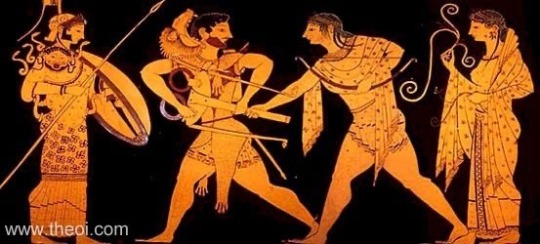
(Pictured: Athena with Aegis, Hercules with lion-skin pelt stealing a tripod from Apollo--who clearly has some thoughts about that since he is grabbing it and trying to pull it away from Hercules, all while the Pythia watches while holding incense in her hand.)
Gods, heroes, spirits, and even certain mortals are illustrated consistently in iconography to be surrounded by their specific encoded trappings--their unique clothing, weapons, holy symbols, and items or even creatures that they have with them. Even the number of dots or lines used in abstract background images have an encoded meaning when they are present. Usually representing the counting of time by days, lunar cycles/months, or even years. The direction of a triangle, pointing up or down, also has a contextual meaning. Even the hairstyle worn by a figure is there to provide context clues for what you are seeing. Nothing is truly background in iconography. All of it works together to identify who the characters are, what they are doing, and when it is happening. It is meant to be read and it is even meant to be somewhat easy to understand at a glance.
The deeper forms of Mediterranean trancework relate to shapeshifting, spirit possession, prophecy, deity Bridalwork, and variations related to those main four. All of these types of rituals involve three things that are not necessary in basic trancework. Those things are:
Legomena. Things recited. Sacred words, sacred chants, spirit threads. When these particular things are spoken in the right way, it induces specific trance effects.
Deiknumena. Things shown. This would be your regalia, food and drink, colors, tools, spirit weapons, body art, etc. Depending on the ritual, these things are either just made visible to the entranced or they are handled, imbibed, or worn.
Dromena. Behaviors. The actions that are prompted by exposure to the combination of legomena and deiknumena.

Shapeshifting
Shapeshifting can be any kind of transformation. It can relate to gender, age, lycanthropy or some other form of animal transformation (bears, wolves, and pigs being the most common), or turning an ordinary mortal into a hero (or anti-hero) for a time. All of which are done in order to accomplish a ritual objective, usually through elaborate ritual dances or through taking on a named role in reenacting a sacred legend. All shapeshifting rituals involve ritually imbibing something that will initiate the transformation, taking on the adornments that go with that transformation (wearing animal skins or essentially dressing the part), there is a ritual objective to be achieved while in that state, and then there is the proof of state--which is usually a demonstration of something inhuman. Like something your average mortal would be unable or unwilling to do in their right mind.
Hero legends are a roadmap for this process. Basically, any hero legend that you can find is something you can recreate through trancework and it was probably done that way in antiquity since that is how it is still done now. Becoming Hercules is something to physically do, to actually participate in. Enacting these types of transformations at specific points in the year helps to facilitate the changing of the seasons. It works to promote the spiritual hygiene of a community since one of the things done as a part of reenacting sacred legends is the blessing of an area. Which only a divinely chosen shapeshifted individual would have the spiritual authority to do.
The keyword here is divinely chosen. That basically just means that this is not something a person chooses to do for themselves as that would reek of hubris. Instead, out of a gathering of people qualified to do the job, some kind of divination process would take place. Usually by drawing lots in some way. The outcome of who does what has to always be left to chance but it is always quality controlled by limiting participation to people who have the spiritual authority to do the job to begin with. So, if a ritual has to do with death gods or heroes, then the pool of folks who draw lots would consist of people whose families have historically worked with the dead (as a mortician, gravedigger, or, to update this for a more modern world, as a coroner). Or they might involve people born under the dog star, or to a family who is under the protection of that collection of gods and spirits, or people born with other signs that would have been identified by a midwife at birth. There are a lot of ways to figure out who does this.
Honestly, at this point in the game, I think the pool is already limited enough so I would say that just feeling compelled to participate in something like this would put you in the group of folks drawing lots. There just aren't often very many of us gathered in any single location. Maybe one day when if there are too many applicants it can be narrowed down in one of the more traditional ways. That would be my suggested adaptation while saving room for the way that it has been done historically.
However, the most important aspect of being chosen to do this is the ability to actually do it. So, if this ritual involves performing 7 ritualized combat dances, you would have to know how to do those dances to even get a foot in the door. Thus we have our first real hurdle with this. Not many converts to Hellenic polytheism know the dances for this stuff or where they should go. The dances are not hard. They would have to be pretty simple and repetitive enough to keep the entranced entranced. All it takes is a little time and dedication. You could learn a traditional dance or remake one using several in the same genre as a guideline.
Heroes and spirits can take part in processionals where they would basically stay in character while moving from one place to another. Mind you, this is a sacred state achieved through trancework and not just cosplay with vibes. I just don't know any other way to describe it to a modern audience. While in such a processional, various archetypes/characters/heroes/spirits will interact with each other in their customary ways. This is the expected dromena mentioned a bit earlier. Each shapeshifted individual has an expected way in which they will behave and they are strictly limited to these behaviors in order for the sacred state to be recognized as valid.
So, during a processional, wicked daemones will run from or obey the sounds of ringing metal (even the clashing of swords). Heroes will be brave and keep spirits in line, protecting those who have gathered to watch. If there are two teams of shapeshifters, they will be antagonistic towards each other. Teams of naughty satyrs will do naughty satyr things to & with observers (within reason).
Watch this video below of the Mamuthones & Issohadores of Sardinia. And go ahead and let the idea that the origin of beings like Krampus are rooted in the processionals of spirits, heroes, and gods of the ancient world. Listen to that rhythm. That is the rhythm of transformation all across the Med. So, the music that goes with this and the movements done with this are evocative and it won't work with just anything. Pop music is fun for getting into the mood but those traditional rhythms and movements have a very specific purpose and all of it together forms an ancient bond between what we do now and what our ancestors have done.
youtube
Deity bridal work functions very similarly to this to the point that it can be virtually indistinguishable from shapeshifting in the results. The main differences between these things is the lead up to the ritual and the permanency of these states. Shapeshifters adopt the role for a limited time frame, Brides are compelled to do this for their entire lives and essentially have to live and behave in a ritual state the entire time.
Upstanding members of the community are traditionally favored for shapeshifting rituals. I know that part of that is just a reward for status but there is also an unspoken and pretty cute element to that as well. To put it simply, it is more fun to watch uptight moral people transform into wild beasts. And being divinely chosen to do it means they don't get to say no because it is an honor to turn into a dancing hairy doof. I will never stop giggling over that.
Shapeshifting rituals are for what we might call sympathetic magic today. They reaffirm our bond with the land and the changing seasons. They allow us to embody our heroes and form a link with our ancestors. It is sacred.
Read more in Part II: Spirit Possession
48 notes
·
View notes
Text
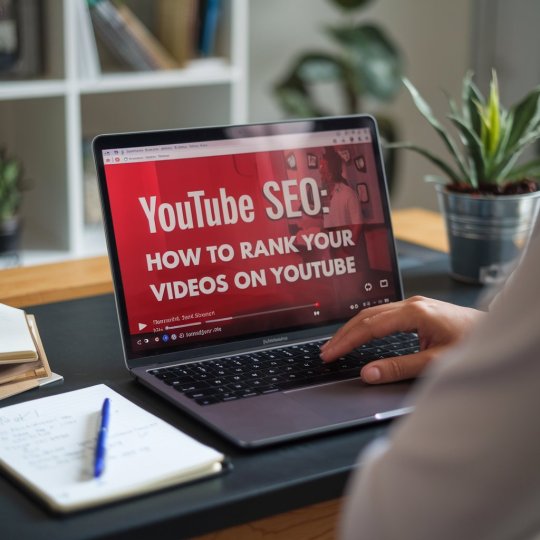
1. Understanding YouTube SEO
YouTube SEO is the process of optimizing your videos to rank higher in YouTube’s search results. Like Google, YouTube uses an algorithm to determine which videos are most relevant to users’ searches. The key ranking factors include:
Watch Time: The total time viewers spend watching your video.
Engagement: Likes, comments, shares, and subscriptions.
Relevancy: How well your video matches a user’s search query.
2. Keyword Research for YouTube
Keyword research is the foundation of YouTube SEO. It helps you understand what terms people are using to search for content similar to yours.
Use Tools: Tools like TubeBuddy, vidIQ, or YouTube’s auto-suggest can help find the right keywords.
Focus on Long-Tail Keywords: These are specific, less competitive phrases that help your content rank faster. For example, instead of "yoga," you might use "beginner yoga for back pain."
Analyze Competitors: Look at the top-performing videos in your niche to find keywords you can use.
3. Optimizing Video Titles
Your title is the first thing viewers see. It must be both engaging and SEO-friendly.
Include Keywords: Your primary keyword should appear naturally in the title. Example: "Yoga for Beginners: Relax and Strengthen with This 20-Minute Routine."
Be Concise: Keep it under 60 characters to ensure it's fully visible.
Create Curiosity: Titles that promise value or solve a problem encourage clicks.
4. Creating SEO-Friendly Descriptions
Video descriptions help YouTube understand your content, making it easier to rank.
Write Detailed Descriptions: Aim for 250-500 words. Include your target keyword in the first 100 characters and sprinkle it naturally throughout the text.
Include Secondary Keywords: Use related keywords to further improve SEO.
Add Timestamps: Break down your video into sections with timestamps to improve user experience and help with ranking.
5. The Power of Tags and Hashtags
Tags and hashtags are a hidden gem for YouTube SEO.
Use Relevant Tags: Add 10-25 tags, including your primary keyword and variations of it. Example: "beginner yoga," "yoga for back pain," "morning yoga."
Leverage Hashtags: You can add hashtags in your title or description to improve discoverability. Ensure they’re relevant to the content, e.g., #YogaForBeginners.
6. Custom Thumbnails for Higher CTR
Your thumbnail is like a billboard for your video. A custom, high-quality thumbnail increases the click-through rate (CTR).
Use Bright Colors: Bright, contrasting colors grab attention.
Include Faces and Emotions: Thumbnails showing human faces tend to get more clicks.
Add Text Sparingly: If you add text, make sure it’s short, bold, and readable even on small devices.
7. Enhancing Viewer Engagement
Engagement signals are critical for boosting rankings.
Encourage Interaction: Ask viewers to like, comment, and subscribe at key moments in your video.
Use End Screens and Cards: These features allow you to promote other videos or playlists, increasing watch time and session duration.
Polls and Questions: Use YouTube’s interactive features like polls to engage your audience.
8. Optimizing Closed Captions and Transcripts
Closed captions and transcripts enhance SEO and accessibility.
Closed Captions: They help non-native speakers and those with hearing impairments. YouTube’s automatic captions aren’t always accurate, so upload your own if possible.
Transcripts: Post the transcript of your video in the description. This makes your content more searchable and helps with keyword relevance.
9. Utilizing Playlists for SEO
Playlists group related videos, improving watch time and SEO.
Create Keyword-Rich Playlists: Organize your videos into playlists using relevant keywords. Example: “Yoga for Beginners,” “Advanced Yoga Poses,” etc.
Boost Engagement: Playlists encourage viewers to continue watching your content, thus improving session time and video ranking.
10. Boosting Watch Time and Session Time
Watch time is one of the most significant factors for YouTube rankings.
Hook Viewers Early: The first 15 seconds of your video are crucial. Use an engaging intro to capture attention right away.
Deliver Value Consistently: Keep your content informative and engaging throughout. Aim for 5-15 minute videos, depending on your topic.
Maintain Session Time: Session time refers to how long a user stays on YouTube after watching your video. Encourage viewers to explore your other content using playlists and end screens.
11. Promoting Your YouTube Videos
Even with SEO, promotion is essential for gaining traction.
Share on Social Media: Post your videos across platforms like Facebook, Instagram, Twitter, and LinkedIn.
Embed on Websites and Blogs: Embed your videos in relevant blog posts to drive traffic from your website.
Collaborate with Other Creators: Partnering with YouTubers in your niche can expand your reach and introduce you to new audiences.
12. Analyzing and Improving with YouTube Analytics
YouTube Analytics is your best friend for tracking performance and making improvements.
Monitor Key Metrics: Track watch time, CTR, audience retention, and traffic sources. These give insights into what’s working and what needs improvement.
Adjust Keywords and Content: If a video isn’t performing well, consider revising your title, tags, or description, or try promoting it again.
Experiment with Different Content Types: Use analytics to identify which video formats (tutorials, vlogs, etc.) resonate most with your audience.
YouTube SEO is an ongoing process, but when done correctly, it can significantly boost your video rankings and channel growth. By focusing on keyword optimization, engagement, and promoting your videos across platforms, you can increase visibility and watch time. Start implementing these strategies today, and watch your YouTube channel thrive!
#youtube#seo#youtube seo#digital marketing#search engine optimization#seo services#youtube video#video promotion#video seo
3 notes
·
View notes
Text
What Is Broad Match Modifier in Keyword Match Types in Display Ads?

In the realm of digital marketing, effective keyword targeting is crucial for the success of your pay-per-click (PPC) campaigns. One of the key components in PPC advertising is understanding and utilizing different keyword match types. Among these, the Broad Match Modifier (BMM) plays a significant role, especially in display ads. This blog explores the concept of Broad Match Modifier, its benefits, and how it influences your PPC strategy.
Understanding Keyword Match Types
Before diving into Broad Match Modifier, it’s essential to understand the various keyword match types available in PPC advertising. These match types dictate how closely a user's search query must match your keyword for your ad to be displayed. The primary match types are:
Broad Match: When someone searches for misspellings, synonyms, related searches, and other pertinent variations, ads might appear.
Phrase Match: Ads may show for searches that match a phrase, or close variations of that phrase, with additional words before or after.
Exact Match: Ads may show for searches that match the exact term or are close variations of that exact term.
Broad Match Modifier (BMM): Ads may show for searches that include the modified term (or close variations, but not synonyms), in any order.
What Is Broad Match Modifier?
Broad Match Modifier (BMM) is a flexible keyword match type that allows advertisers to have more control over their PPC campaigns than Broad Match while maintaining some flexibility. BMM is created by adding a plus sign (+) before one or more words in a broad match keyword. For example, if your broad match keyword is "running shoes," the BMM version would be "+running +shoes."
Benefits of Using Broad Match Modifier
Enhanced Control Over Keywords: BMM gives advertisers more control compared to Broad Match. By specifying which words must be included in the user's search query, advertisers can filter out irrelevant traffic and focus on more qualified leads.
Increased Reach: While providing more control, BMM still offers a broader reach compared to Phrase and Exact Match. This balance makes it an excellent choice for expanding your audience while maintaining relevance.
Cost-Effectiveness: By targeting more relevant search queries, BMM can lead to a higher click-through rate (CTR) and conversion rate, making your campaigns more cost-effective. You’re less likely to spend on clicks from users who are not interested in your product or service.
Flexibility in Ad Targeting: BMM allows for variations in the order and presence of additional words in search queries. This flexibility can capture a wide range of search terms related to your keywords, increasing the chances of your ad being displayed to potential customers.
How to Implement Broad Match Modifier in Display Ads
Keyword Research: Start with thorough keyword research to identify relevant keywords for your campaign. Use tools like Google Keyword Planner to find terms that potential customers are searching for.
Add Modifiers: Add a plus sign (+) before the essential words in your keywords that you want to appear in users’ search queries. For example, "+digital +marketing +services" ensures that any search containing these words, in any order, will trigger your ad.
Monitor Performance: Regularly monitor the performance of your BMM keywords. Analyze metrics such as CTR, conversion rate, and cost per conversion to determine the effectiveness of your keywords and make adjustments as needed.
Optimize and Adjust: Based on performance data, optimize your keyword list by adding negative keywords to exclude irrelevant searches and refining your BMM keywords for better results.
Case Study: Success with Broad Match Modifier
Consider a PPC campaign for a PPC company offering digital marketing services. Initially, the campaign used Broad Match keywords, resulting in a high volume of clicks but low conversion rates due to irrelevant traffic. By switching to Broad Match Modifier keywords such as "+PPC +company" and "+digital +marketing +services," the company achieved:
Higher CTR: More relevant ads led to a significant increase in CTR.
Improved Conversion Rates: The traffic became more qualified, leading to higher conversion rates.
Lower Cost Per Conversion: More relevant traffic meant fewer wasted clicks, reducing the overall cost per conversion.
Best Practices for Using Broad Match Modifier
Combine with Negative Keywords: Use negative keywords in conjunction with BMM to further refine your targeting and exclude irrelevant traffic. This ensures that your ads are only shown to users with a high likelihood of converting.
Regularly Update Your Keyword List: Continuously analyze and update your keyword list based on performance data. Add new BMM keywords that are performing well and remove or adjust those that are not meeting your goals.
Use Analytics to Guide Decisions: Leverage analytics tools to track the performance of your BMM keywords. Pay attention to key metrics such as CTR, conversion rate, and return on ad spend (ROAS) to make data-driven decisions.
Test and Experiment: Continuously test different BMM keywords and combinations to find the most effective strategy for your campaign. Try out many iterations to determine which produce the greatest outcomes.
Conclusion
The Broad Match Modifier is a valuable tool in the PPC arsenal, offering a balance between reach and control. By implementing BMM in your keyword strategy, you can improve the relevance of your ads, increase engagement, and achieve better overall campaign performance. Incorporate these practices into your Digital Marketing services strategy to maximize the impact of your PPC campaigns and drive better results for your business.
2 notes
·
View notes
Text
Google Ads Help to Grow Your Buisness
Mastering Google Ads: A Comprehensive Guide
As a leading Digital Marketing Agency with extensive experience in Google Ads, we understand the immense potential this platform offers for businesses of all sizes. Whether you're a small startup or an established enterprise, leveraging Google Ads effectively can be the key to driving growth, increasing brand visibility, and maximizing ROI. In this article, we’ll guide you through the intricacies of Google Ads, from setting up your first campaign to advanced optimization techniques.
1. Introduction to Google Ads
Google Ads is a powerful online advertising platform that allows businesses to reach their target audience through a variety of ad formats. Whether your goal is to generate leads, increase sales, or build brand awareness, Google Ads provides a range of tools and strategies to achieve your objectives.
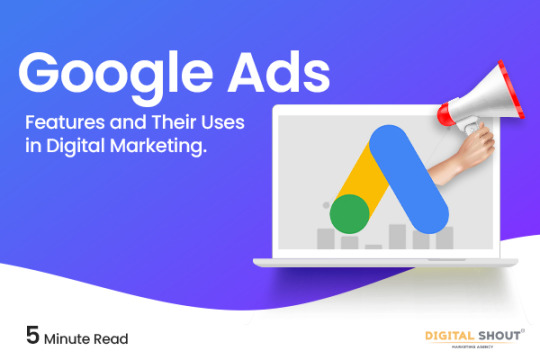
2. How Google Ads Works
The Pay-Per-Click (PPC) Model: Google Ads operates on a Pay-Per-Click (PPC) model, meaning you only pay when someone clicks on your ad. This model ensures that your advertising budget is spent on potential customers who are actively interested in your products or services.
Ad Auction Process: Every time a user performs a search, Google Ads runs an auction to determine which ads will appear and in what order. The ad rank is determined by a combination of your bid amount, the quality of your ad, and the expected impact of your ad extensions.
Ad Formats: Google Ads offers a variety of ad formats, including:
Search Ads: Text ads that appear on Google search results pages.
Display Ads: Visual ads that appear on websites within Google’s Display Network.
Video Ads: Ads that appear on YouTube and other video partners.
Shopping Ads: Product-based ads that appear in Google Shopping results.
3. Setting Up a Google Ads Campaign
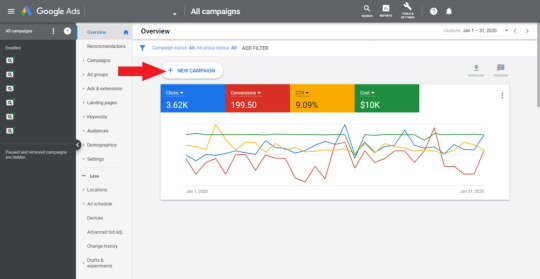
Creating an Account: To start using Google Ads, you need to create an account. This involves providing basic information about your business, such as your website and payment details. Once your account is set up, you can begin creating campaigns.
Choosing Campaign Objectives: Google Ads allows you to choose from several campaign objectives, such as Sales, Leads, or Website Traffic. Selecting the right objective is crucial, as it determines how your ads are optimized and where they appear.
Keyword Research and Selection: Effective keyword research is the foundation of a successful Google Ads campaign. Tools like Google’s Keyword Planner can help you identify relevant keywords that your potential customers are searching for. Selecting the right keywords ensures that your ads are shown to the right audience.
Ad Creation and Targeting: Writing compelling ad copy is essential for attracting clicks. Your ads should be clear, concise, and relevant to the user’s search intent. Google Ads also offers extensive targeting options, allowing you to reach your audience based on demographics, location, interests, and more.
Bidding Strategies: Google Ads provides various bidding strategies, including Manual CPC (Cost-Per-Click), Enhanced CPC, and Target CPA (Cost-Per-Acquisition). The choice of strategy depends on your campaign goals and budget. For example, Target CPA is ideal for campaigns focused on generating conversions.
4. Optimizing Google Ads Campaigns
Tracking and Measuring Performance: To assess the effectiveness of your Google Ads campaigns, it's crucial to set up conversion tracking. This allows you to measure actions taken by users after clicking on your ad, such as purchases or sign-ups. Key metrics to monitor include Click-Through Rate (CTR), Conversion Rate, and Quality Score.
A/B Testing: A/B testing, also known as split testing, involves running two or more variations of an ad to see which performs better. This can help you refine your ad copy, headlines, and calls-to-action to improve overall performance.
Budget Management: Effective budget management ensures that you maximize your ad spend without overspending. Google Ads allows you to set daily budgets and adjust them based on campaign performance. Allocating your budget to high-performing campaigns can lead to better results.
Continuous Optimization: Google Ads is not a “set it and forget it” platform. Regularly reviewing and optimizing your campaigns is essential for maintaining and improving performance. This might involve adjusting bids, refining keywords, or updating ad copy based on what’s working best.
5. Common Challenges and How to Overcome Them
High Competition and CPC: In competitive industries, the cost-per-click (CPC) can be high. To compete effectively, focus on improving your Quality Score by creating highly relevant ads and landing pages. Additionally, consider targeting long-tail keywords with less competition.
Ad Fatigue: Over time, users may become less responsive to your ads, a phenomenon known as ad fatigue. To combat this, regularly update your ad creatives and rotate different versions to keep your audience engaged.
Low Click-Through Rates (CTR): If your ads are not receiving enough clicks, it could indicate that they are not resonating with your audience. Improving your ad relevance, crafting stronger calls-to-action, and testing different headlines can help increase CTR.
Budget Management Issues: It’s easy to overspend on Google Ads if you’re not careful. Regularly monitoring your spend and adjusting your budgets based on performance is crucial. Focus on campaigns that deliver the best ROI and reduce spending on underperforming ones.
6. Advanced Google Ads Strategies
Remarketing: Remarketing allows you to target users who have previously visited your website but didn’t convert. By showing them tailored ads as they browse other websites, you can re-engage them and increase the likelihood of conversion.
Using Google Ads Extensions: Ad extensions provide additional information about your business, such as contact details, additional links, or promotional offers. Using extensions can improve your ad’s visibility and performance by making it more informative and appealing to users.
Automated Bidding and Smart Campaigns: Google’s automated bidding strategies use machine learning to optimize your bids in real-time, based on factors like user behavior and conversion history. Smart Campaigns are a fully automated option that can simplify campaign management, especially for small businesses.
Integration with Google Analytics: Linking your Google Ads account with Google Analytics provides deeper insights into user behavior on your website. This data can help you refine your campaigns and improve targeting by understanding how users interact with your site after clicking on your ads.
7. Case Studies and Success Stories
Examples of Successful Google Ads Campaigns: We've seen numerous success stories across various industries where Google Ads played a pivotal role in driving business growth. For instance, a client in the e-commerce sector achieved a 200% increase in online sales within six months by leveraging a combination of Search Ads and remarketing strategies.
What Can Be Learned from Failures: Not every campaign is a success, and there are valuable lessons to be learned from failures. Common pitfalls include poor keyword selection, lack of targeting, and inadequate budget management. Learning from these mistakes can help you avoid them in your future campaigns.So get attach with expertise of Imagency Media Ad Service
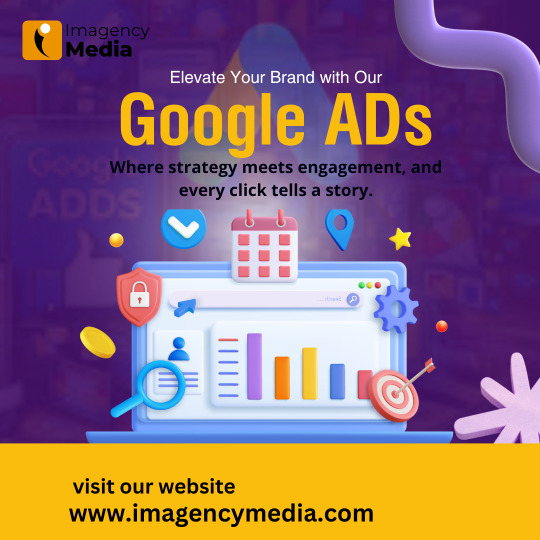
8. Future Trends in Google Ads
Automation and AI in Google Ads: The future of Google Ads is increasingly focused on automation and artificial intelligence. These technologies are enabling more precise targeting and bid optimization, allowing advertisers to achieve better results with less manual intervention.
Privacy Concerns and Regulations: As privacy regulations evolve, Google Ads is adapting by offering more privacy-focused solutions. This includes new ways to target users without relying on third-party cookies, ensuring that advertisers can continue to reach their audience while respecting user privacy.
9. Conclusion
Google Ads remains one of the most effective tools for driving online traffic and achieving business goals. By understanding how the platform works and continuously optimizing your campaigns, you can achieve significant results. As a trusted digital marketing agency, we are here to help you navigate the complexities of Google Ads and unlock its full potential for your business. Whether you're just starting or looking to optimize existing campaigns, our expertise can help you achieve your marketing objectives.
#digital marketing#digital services#google ads#search engine optimization#seo#social media marketing#branding#business
2 notes
·
View notes